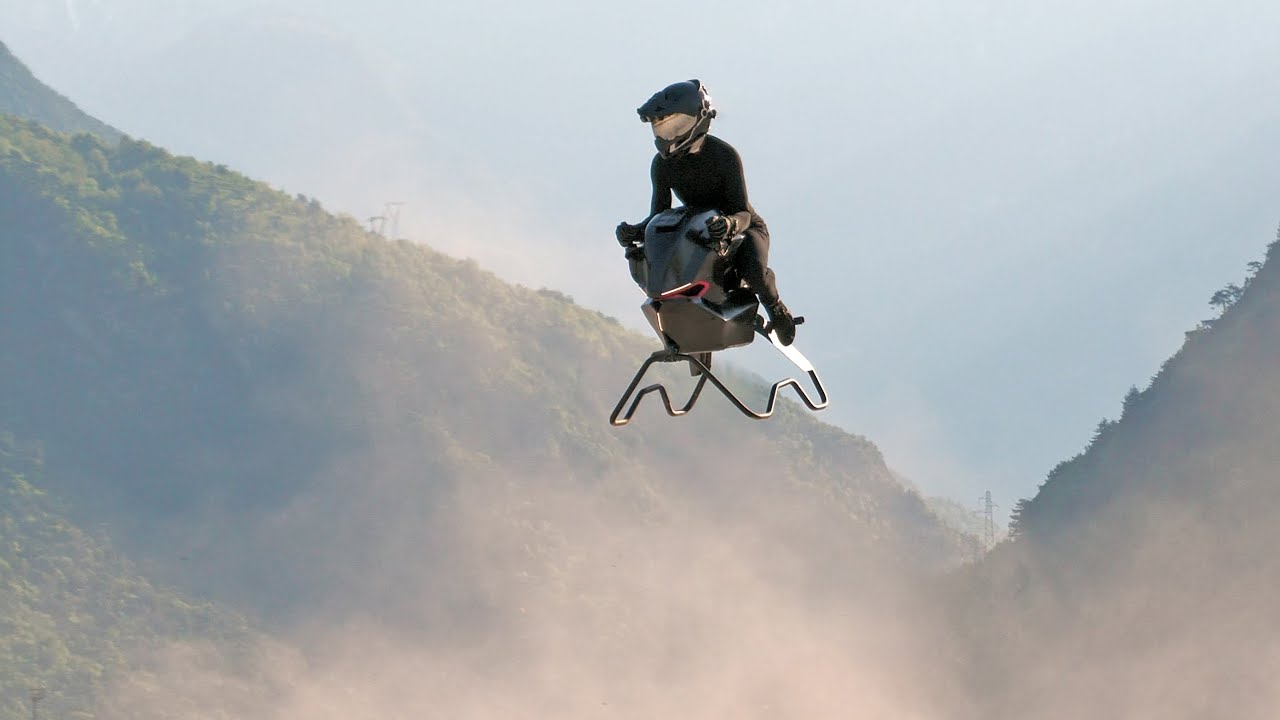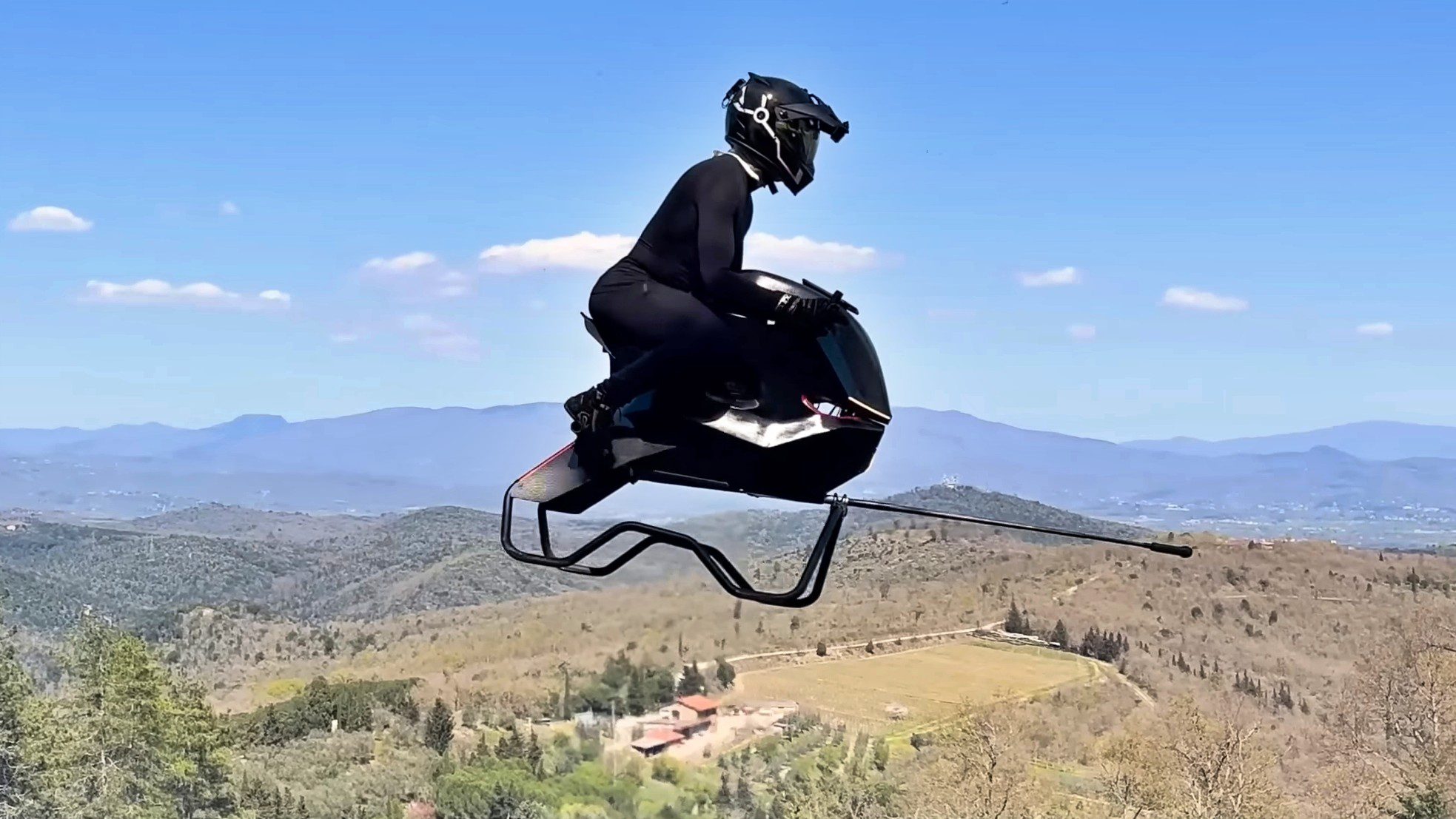What Is the Volonaut Airbike?
The Volonaut Airbike is a personal hoverbike, meaning it's a one-person flying machine that runs on jet turbine propulsion instead of traditional helicopter rotors or electric drone-style propellers. It’s the brainchild of Polish engineer Tomasz Patan, and it’s one of the most exciting steps forward in the world of flying technology.
What makes this different from other flying machines? It doesn’t use big spinning rotors like drones or helicopters. Instead, it uses tiny jet engines to generate lift. That means it can take off and land vertically (VTOL) without needing a runway or spinning blades.
The design looks like a stripped-down superbike or racing motorcycle, but it flies using jet thrust. It’s compact, minimal, and super futuristic, honestly, it looks like it was pulled straight out of a sci-fi movie.
How Does It Work?
The Airbike is powered by micro jet turbines. These are small but powerful engines that push air downward with high velocity, allowing the bike to hover and fly.
Let me break down the key components and how it all comes together:
Jet Propulsion: The bike has multiple jet turbines that provide enough thrust to lift both the machine and the rider off the ground.
Ultra-Light Design: The body is made of carbon fiber and 3D-printed materials, keeping the total weight extremely low, around 30 to 40 kilograms.
Flight Stabilization System: There’s a smart computer inside that constantly balances the hoverbike while flying. It adjusts the engine output in real-time to keep everything steady.
Helmet-Controlled Telemetry: Here’s something really cool, the rider wears a telemetry helmet that’s connected to the Airbike. You control the direction and tilt just by leaning your body, kind of like how you’d steer a bike or a skateboard.
When you put it all together, the result is a flying experience that feels natural and intuitive, almost like you're gliding through the air just by shifting your weight.
Key Features That Make It Unique
Here are the most impressive features of the Volonaut Airbike:
Made from carbon fiber and 3D-printed parts
Incredibly lightweight, only 30 to 40 kg
Reaches speeds up to 200 km/h (124 mph)
VTOL (Vertical Takeoff and Landing) capability
Uses redundant jet turbines for safety
Can fly for about 10 minutes per refuel
Refuels in less than a minute using jet fuel
Maximum rider weight is around 95 kg (209 lbs)
Controlled via helmet telemetry and body lean, no joystick required
Doesn’t need a pilot license in the U.S, it qualifies as an FAA ultralight aircraft
These features combine to offer something that hasn’t really existed before: a personal, jet-powered flying bike that regular people can (potentially) ride.
Is the Volonaut Airbike Actually Real?
If your first reaction was, "This has to be fake", you’re not alone. It really does look like CGI at first glance. No rotors, no wings, just a sleek frame hovering and flying through the air.
But here's the thing, it's very real.
You can hear authentic engine noise in the videos.
There’s visible heat distortion from the jet turbines.
Test pilots are shown interacting with the bike physically.
Uncut, multi-angle footage shows the bike taking off and landing without wires or props.
So yes, the Airbike isn’t just a concept design, it’s a functioning prototype that flies using actual jet propulsion. That’s a massive breakthrough.
Who Built It?
The Volonaut Airbike is designed by Tomasz Patan, who’s also one of the creators of the Jetson ONE, an electric flying car. His company, Volonaut, is taking the flying vehicle concept one step further with jet technology.
What’s different here is the use of jet turbines instead of electric rotors. It makes the Airbike more powerful and potentially faster, though flight duration is shorter for now.
Tomasz and his team are clearly focused on creating something bold, not just practical transportation, but something that feels thrilling, futuristic, and one-of-a-kind.
Price and Availability
As of now, the Airbike is not a mass-market product, but it will be available for pre-order soon.
Expected Price: About $880,000 USD
Pre-orders Open: Starting August 1, 2025, through the official Volonaut website
Yes, it’s expensive. But that’s expected for an entirely new category of flying machine. Early adopters, collectors, and tech enthusiasts with deep pockets are the main audience for now.
Like all tech, the cost could come down in the future as production scales and new models are introduced.
What Can You Actually Use It For?
So what’s the point of a flying bike that only runs for 10 minutes? Actually, it has some interesting and valuable uses:
Aerial Adventure: Perfect for thrill-seekers and adrenaline junkies
Stunt Shows & Expos: Great for demonstrating futuristic tech
Luxury Experiences: Could be part of VIP adventure packages
Testing & Research: Useful for pushing the boundaries of personal flight technology
Right now, it’s not designed for city commuting. But it’s an important proof-of-concept for future versions that might be.
Why It Matters for the Future
The Volonaut Airbike is more than just a cool gadget. It hints at the future of personal transportation.
We could see jet-powered taxis or delivery drones within the next decade.
Smart helmets and gesture-based controls might become standard in aviation.
This could pave the way for more eco-friendly or electric jet variants.
Urban skies might be filled with personal flight paths, just like roads today.
We’re still a few years away from widespread adoption, but innovations like the Airbike are shaping the direction things are going. The technology is real, the potential is massive, and the dream of flying like a superhero is starting to feel possible.
Final Thoughts
To sum it all up, the Volonaut Airbike is not science fiction anymore. It’s a bold, real, and flying machine that gives us a glimpse into what’s possible.
It may not be affordable for most of us right now. But it’s a sign of progress, and proof that people like Tomasz Patan are working hard to make the impossible, possible.
We’re entering a new age of aviation, where flight might soon be as personal and accessible as riding a bike.
Would I love to ride it? Absolutely.
Would you?
Drop a comment below and let’s talk about whether the Volonaut Airbike is something you'd dare to fly or whether we’re still dreaming too high.


Comments
Post a Comment